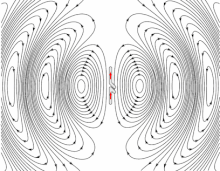Radio wave

- Home
- /
- POSTS
- /
- Technology
- /
- Radio wave
Radio waves are a type of electromagnetic radiation with the longest wavelengths in the electromagnetic spectrum, typically with frequencies of 300 gigahertz (GHz) and below.
At 300 GHz, the corresponding wavelength is 1mm, which is shorter than the diameter of a grain of rice. At 30 Hz the corresponding wavelength is ~10,000 kilometers (6,200 miles), which is longer than the radius of the Earth. Wavelength of a radio wave is inversely proportional to its frequency, because its velocity is constant.
Like all electromagnetic waves, radio waves in a vacuum travel at the speed of light, and in the Earth’s atmosphere at a slightly slower speed. Radio waves are generated by charged particles undergoing acceleration, such as time-varying electric currents.
Naturally occurring radio waves are emitted by lightning and astronomical objects, and are part of the blackbody radiation emitted by all warm objects.
 Radio waves are generated artificially by an electronic device called a transmitter, which is connected to an antenna which radiates the waves. They are received by another antenna connected to a radio receiver, which processes the received signal.
Radio waves are generated artificially by an electronic device called a transmitter, which is connected to an antenna which radiates the waves. They are received by another antenna connected to a radio receiver, which processes the received signal.
Radio waves are very widely used in modern technology for fixed and mobile radio communication, broadcasting, radar and radio navigation systems, communications satellites, wireless computer networks and many other applications.
Different frequencies of radio waves have different propagation characteristics in the Earth’s atmosphere; long waves can diffract around obstacles like mountains and follow the contour of the Earth (ground waves), shorter waves can reflect off the ionosphere and return to Earth beyond the horizon (skywaves), while much shorter wavelengths bend or diffract very little and travel on a line of sight, so their propagation distances are limited to the visual horizon.
To prevent interference between different users, the artificial generation and use of radio waves is strictly regulated by law, coordinated by an international body called the International Telecommunication Union (ITU), which defines radio waves as “electromagnetic waves of frequencies arbitrarily lower than 3,000 GHz, propagated in space without artificial guide”.
The radio spectrum is divided into a number of radio bands on the basis of frequency, allocated to different uses.









